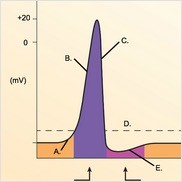What are the five major types of leukocytes in vertebrate blood, and what are their functions?
What will be an ideal response?
Answer: a. Leukocytes are involved in the immune response.
b. Neutrophils engulf damaged cells and pathogens by phagocytosis.
c. Eosinophils deliver cytotoxic chemicals and enzymes that kill parasites. They are also involved in allergic reactions.
d. Basophils leave the circulatory system and accumulate at sites of infection. They release toxic chemicals to kill pathogens in the interstitial space. They are involved in inflammation.
e. Macrophages are phagocytic cells that engulf pathogens and dead cells. They mature from monocytes, which are white blood cells that circulate only briefly in the blood.
f. Lymphocytes are present in multiple types. Some make antibodies (B cells), and some facilitate an immune response by secreting molecules that activate other lymphocytes (helper T cells). Others secrete cytotoxic agents that kill invaders or dying cells (killer T cells).
You might also like to view...
White blood cells engulf bacteria through the process of __________.
Fill in the blank(s) with the appropriate word(s).
RER is most abundant in cells specialized for steroid production
Indicate whether the statement is true or false
Neonates will take their first breath only after umbilical cord vessels have been clamped.
Answer the following statement true (T) or false (F)
 The figure illustrates changes in the membrane potential during an action potential. What does "C" represent?
The figure illustrates changes in the membrane potential during an action potential. What does "C" represent?
A. Repolarization B. Depolarization C. Afterpotential D. Local potential E. Threshold